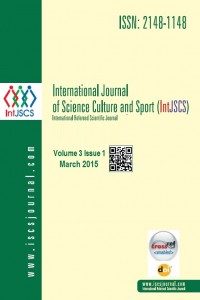Investigation of Professional Readiness of Selected Male and Female Experts in Iranian Sports Organizations
Öz
This study aims to investigate professional readiness of a selected group of male and female experts in Iranian sports organizations. It is a descriptive study with an applied objective. The statistical population of the study includes the entire selected male and female experts (406 experts) of Iranian sports organizations among which 352 cases cooperated with the researchers and therefore were selected as research sample. Measurement tool is the professional readiness assessment standard questionnaire (Aliabadi, 2014); the validity and reliability of this questionnaire have been approved by sport experts. The descriptive and inferential statistics including KS- and T-test was used to analyze the data. The results indicate that there is no significant difference between male and female experts in sports organizations regarding mental readiness and its components (motivation, commitment, confidence); but there is a significant difference at 0.01 level between them with regard to work readiness and its components (skill, knowledge, experience). Moreover, based on the average of work/technical readiness components, male experts are better than female experts.
Anahtar Kelimeler
Kaynakça
- Aghaii N (2010). Comparing readiness level of managers and staff in physical education section of Iranian universities and its relationship to effective decision-making. Journal of Sports Management and Motor Behavior (Vol. 6), 12, 69-82.
- Cardano M, Scherer R & Owen C (2002). Attitude toward women as managers: Sex versus culture. Women in Management Review (Vo1. 17), 2.
- Ehsani M (2008). Reviewing and ranking the factors hindering the promotion of women to managerial positions in Khuzestan sports organizations. Journal of Sports Science, 19, 189 -171.
- Hart PD (2008). How should colleges assess and improve student learning? Employers’ views on the accountability challenge, a survey of employers conducted on behalf of The Association of American Colleges and Universities. Washington D.C.: Peter D. Hart Research Associates, Inc.
- Hersey P (1985). Situational selling. Escondido, Calif: Center for Leadership Studies.
- Hersey P, Blanchard K & Keilty J (1995). Readiness style match instrument, Center for Leadership Studies, Escondido, CA92025.
- Hersey P & Blanchard K (1996). Life cycle theory of leadership. Training and Development Journal.
- Hersey P & Blanchard K (2004). Management of Organizational Behavior (5th ed.). G. Kabiri (Trans.). SID Press (Majed).
- Hersey P & Blanchard K (2005). Management of organizational behavior: Utilizing human resources. Prentice Hall. 175-177.
- Hersey P, & Blanchard K (2006). Management of organizational behavior. A. Alaghemand (Trans.). Tehran: Amir-Kabir.
- Hewitt BL (1995). Leadership styles and organizational competence in intercollegiate athletic programs affiliated with NCA a division LA Universities: Perception of administrative staff. Southern Illinois University at Carbondale. Retrieved at www.proquest.com.
- McClelland DC, Atkinson JW, Clark RA & Lowell EL (1953). The achievement motive. New York: Appleton – Century-Crofts.
- Mirghafouri SH (2006). Identifying and ranking the effective factors contributing to the failure to appoint women to managerial positions in government agencies in Yazd province. Journal of Women’s Studies, 1, 122-101.
- Schliesman ES (2001). Situational and member characteristics, leader behaviors and follower satisfaction (A leadership study in the sports setting, sports leadership, situational leadership). The University of Tennessee. Retrieved at www.proquest.com.
- Wang X & Hal KW (1991). Readiness and achievement motivation: An investigation of the validity of the readiness scales in Hersey and Blanchard’s situational leadership. Paper presented at the Annual Meeting of the Mid-South Educational Research Association (November 20th), 12-15.
Öz
Kaynakça
- Aghaii N (2010). Comparing readiness level of managers and staff in physical education section of Iranian universities and its relationship to effective decision-making. Journal of Sports Management and Motor Behavior (Vol. 6), 12, 69-82.
- Cardano M, Scherer R & Owen C (2002). Attitude toward women as managers: Sex versus culture. Women in Management Review (Vo1. 17), 2.
- Ehsani M (2008). Reviewing and ranking the factors hindering the promotion of women to managerial positions in Khuzestan sports organizations. Journal of Sports Science, 19, 189 -171.
- Hart PD (2008). How should colleges assess and improve student learning? Employers’ views on the accountability challenge, a survey of employers conducted on behalf of The Association of American Colleges and Universities. Washington D.C.: Peter D. Hart Research Associates, Inc.
- Hersey P (1985). Situational selling. Escondido, Calif: Center for Leadership Studies.
- Hersey P, Blanchard K & Keilty J (1995). Readiness style match instrument, Center for Leadership Studies, Escondido, CA92025.
- Hersey P & Blanchard K (1996). Life cycle theory of leadership. Training and Development Journal.
- Hersey P & Blanchard K (2004). Management of Organizational Behavior (5th ed.). G. Kabiri (Trans.). SID Press (Majed).
- Hersey P & Blanchard K (2005). Management of organizational behavior: Utilizing human resources. Prentice Hall. 175-177.
- Hersey P, & Blanchard K (2006). Management of organizational behavior. A. Alaghemand (Trans.). Tehran: Amir-Kabir.
- Hewitt BL (1995). Leadership styles and organizational competence in intercollegiate athletic programs affiliated with NCA a division LA Universities: Perception of administrative staff. Southern Illinois University at Carbondale. Retrieved at www.proquest.com.
- McClelland DC, Atkinson JW, Clark RA & Lowell EL (1953). The achievement motive. New York: Appleton – Century-Crofts.
- Mirghafouri SH (2006). Identifying and ranking the effective factors contributing to the failure to appoint women to managerial positions in government agencies in Yazd province. Journal of Women’s Studies, 1, 122-101.
- Schliesman ES (2001). Situational and member characteristics, leader behaviors and follower satisfaction (A leadership study in the sports setting, sports leadership, situational leadership). The University of Tennessee. Retrieved at www.proquest.com.
- Wang X & Hal KW (1991). Readiness and achievement motivation: An investigation of the validity of the readiness scales in Hersey and Blanchard’s situational leadership. Paper presented at the Annual Meeting of the Mid-South Educational Research Association (November 20th), 12-15.
Ayrıntılar
| Birincil Dil | İngilizce |
|---|---|
| Bölüm | Makaleler |
| Yazarlar | |
| Yayımlanma Tarihi | 12 Mayıs 2015 |
| Yayımlandığı Sayı | Yıl 2015 Cilt 3 - Sayı 1 |


